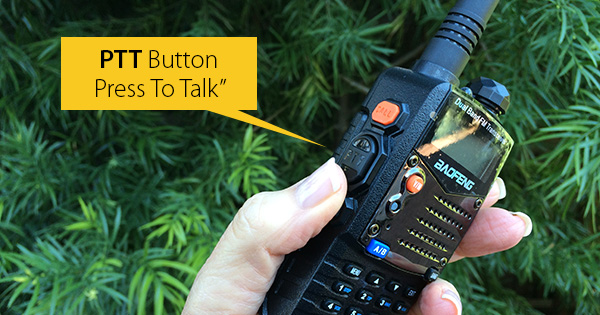What to Do When All Communications Are Down
After a disaster, communication will be of the utmost importance. As CERTs, we have to plan for the worst-case scenario, which means no phones, no cell service and no text messaging. The next available tool is good old-fashioned hand-held radios!
There are different kinds of radios and we’ll discuss those options in the next blog. First, let’s discuss basic radios how-to’s and general protocols. For purposes of this post, we will refer to the radios as “hand-held”, commonly called a walkie-talkie.
First, when setting up a radio network in your neighborhood, you have to agree, in advance, on the frequency (or channel) you and your neighbors will use. For example, you might decide to use Channel 3.
Rather watch a video? Mill Valley has a video to walk through how to use a radio.
How to Make a Call
On the left side of the hand-held radio is a button, called PTT, which stands for “Press To Talk.” Since others may be waiting to use the frequency, it’s important to keep your messages short—so think of what you want to say before you press the key!
To make a call, press PTT and first say the station you want to call, and then your name or station. Remember, when you have the PTT key pressed, you are transmitting—and your radio cannot receive incoming signals until you release the key. So when you finish your message, say “over” “Over” means you are waiting for a response; immediately release the button, and listen carefully for the response to your station.
For example:
“CERT command, this is Team Three, over.”
Don’t say anything more until you hear an acknowledgement:
“Team Three, this is CERT Command, go ahead.”
Tip: There is often a short delay in radio signal being sent; so after pressing PTT, take a breath before starting to say anything.
What if a Call is In Progress
If you tune into your channel and there is a conversation going on, you wouldn’t want to interrupt a call in progress unless your message is clearly more important. To interrupt a call you would say:
“Break-break, this is Team Three, priority message.”
Again, wait to be acknowledged before saying more.
How to End a Call
Once you have completed your conversation, press PTT and say:
“CERT Command, this is Team Three, out.”
You can also use the word “clear” which is interchangeable with “out”. Both mean you are no longer expecting a response, and is the signal for another team to get on the channel with CERT Command.
(As you can see, the classic movie phrase “over and out” makes no sense at all: “Over” means you are expecting a comeback, while “out” means you are finished, and the frequency is clear.)
Best Practices
- When carrying a radio on a CERT team, do not turn down the volume while you are dealing with a situation, no matter how tense. If CERT command is trying to reach you, and you cannot hear them, they will assume you are in trouble and will send out a rescue team to your last location. You will have unwittingly become a victim, using up resources unnecessarily. If you have to turn the radio off, or leave the radio, call CERT Command to tell them that.
- When you use the radio, make sure you are holding the antenna vertically, so that it points straight up—NOT over-the shoulder like a cell phone. Speak across the front of the radio, not directly into it, and always (even in noisy situations) in a normal tone of voice. Shouting into the radio will distort the signal and make it difficult (or impossible) for the other end to understand you.
- Face in the direction of the station you are trying to contact; radio waves do not carry through water, and you are (mostly) water! That’s why radio signals won’t travel as far when you are calling from the rainy woods, for example.
- It is also essential that you speak calmly, even in a terrible situation. Panic and terror are highly contagious, especially when heard over the radio. People who act in panic very frequently become victims; and you don’t want to cause others to become panicked and thus become injured themselves. So use that short breath after pressing the PTT to calm down.
- If CERT Command does not immediately acknowledge your initial call, wait a few moments before calling again. It is entirely possible that they are trying to handle many different tasks, dealing with their EOC (Emergency Operation Center) command or another team’s requests on another frequency, and cannot immediately respond. After your second or third call, they may well respond with a brief “Team Three, CERT Command; stand by.” That’s a sure sign they’re crazy busy. Wait patiently, but don’t be surprised if they forget that you are standing by. After a while, try again. If it’s an urgent matter, tell them that: “CERT Command, Team Three standing by with a priority message.” But if it’s NOT urgent, don’t say so.
Those are the basics of radio operations. Next post we’ll look at different kinds of radios and the ever-important battery management.

